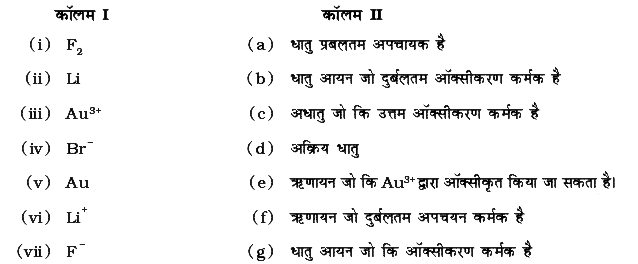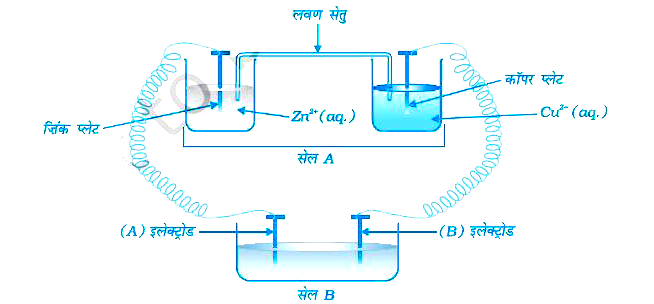निम्नलिखित आँकड़ो के आधार पर कॉलम I और कॉलम II के मदों को सुमेलित कीजिए |
EөF2/F−=2.87V,EөLi+/Li=−3.5V,EөAu3+/Au=1.4V,EөBr2/Br−=1.09V

(i) → (c) (ii) → (a) (iii) → (g) (iv) → (e) (v) → (d) (vi) → (b) (vii) → (g), (f)
Topper's Solved these Questions
- विद्युत रसायनBOOK - NCERT EXEMPLAR HINDICHAPTER - विद्युत रसायनEXERCISE - अभिकथन एवं तर्क प्ररूप प्रश्न
10 Videos
- विद्युत रसायनBOOK - NCERT EXEMPLAR HINDICHAPTER - विद्युत रसायनEXERCISE - दीर्घ उत्तर प्रश्न
8 Videos
- विद्युत रसायनBOOK - NCERT EXEMPLAR HINDICHAPTER - विद्युत रसायनEXERCISE - लघु उत्तर प्रश्न
22 Videos
- रासायनिक बलगतिकी BOOK - NCERT EXEMPLAR HINDICHAPTER - रासायनिक बलगतिकी EXERCISE - दीर्घ उत्तर प्रश्न
5 Videos
- विलयन BOOK - NCERT EXEMPLAR HINDICHAPTER - विलयन EXERCISE - VI. दीर्घ उत्तर प्रश्न
7 Videos
Similar Questions
अभिकथन - Cu हाइड्रोजन की तुलना में कम क्रियाशील है।
तर्क -EөCu2+/Cu ऋणात्मक है।
View Solutionचित्र के आधार पर निम्नलिखित प्रश्नों के उत्तर दीजिए।

सेल 'A' का Eसेल=2V तथा सेल 'B' का Eसेल = 1.1V है। 'A' तथा 'B' दोनों सेलों में से कौन-सा सेल विद्युत् अपघटनी सेल के रूप में कार्य करेगा। इस सेल में होने वाली इलेक्ट्रोड अभिक्रियाएँ क्या होंगी?
View Solutionक्या किसी इलेक्ट्रोड का परिशुद्ध इलेक्ट्रोड विभव मापा जा सकता है?
View Solutionसभी पर्याप्त ऊर्जा धारित संघट्ट रासायनिक परिवर्तन में परिणित नहीं होते इसे एक उदाहरण की सहायता से समझाइए।
View Solutionकिसी विलयन की सांद्रता को व्यक्त करने के लिए निम्नलिखित पदों को परिभाषित कीजिए। इनमें से कौन-सा तरीका ताप पर निर्भर नहीं करता है तथा क्यों?
(i) w/w (द्रव्यमान प्रतिशत) (ii) V/V(आयतन प्रतिशत) (iii) w/V(आयतन से भार प्रतिशत) (iv) ppm. (पार्ट्स पर मिलियन) (v) x (मात्रा अश) (vi) M (मोलरता) (vii) m (मोललता)
View SolutionMatch the items of Column I and Column II on the basis of data given below: (One to one match only) E_(F_(2)|F^(-))^(@) = 2.87 V, E_(Li^(+)|(Li) = -3.5 V, E_(Au^(3+)|Au)^(@) = 1.4 V, E_(Br_(2)|Br^(-))^(@) = 1.09V
View SolutionIf E∘Au+/Au is 1.69 V and E∘Au3+/Au is 1.40 V, then E∘Au+/Au3+ will be :
View SolutionMatch the items of Column I and Column II on the basis of data given below : E_(F_(2)//F^(-))^(Ï´)=2.87" V ",E_(Li^(+)//Li)^(Ï´)=3.5" V ",E_(Au^(3+)//Au)^(Ï´)=1.4" V ",E_(Br_(2)//Br^(-))^(Ï´)=1.09" V "
View SolutionArrange the following metals in increasing order of their reducing power.
[ Given : E∘K+/K=−2.93V,E∘Ag+/Ag=+0.80V,E∘Al3/Al=−1.66V,E∘Au3+/Au=+1.40V,E∘Li+/Li=−3.05V]
View SolutionIf E_(Au^(+)// Au)^(@) is 1.69 V and E_(Au^(3+)//Au)^@ is 1.40 V . Then E_(Au^(+)//Au^(3+))^(@) will be :
View SolutionMatch the items of Column I and Column II on the basis of data given below: (One to one match only) E_(F_(2)|F^(-))^(@) = 2.87 V, E_(Li^(+)|(Li) = -3.5 V, E_(Au^(3+)|Au)^(@) = 1.4 V, E_(Br_(2)|Br^(-))^(@) = 1.09V
View SolutionIf E∘Au+/Au is 1.69 V and E∘Au3+/Au is 1.40 V, then E∘Au+/Au3+ will be :
View SolutionE^(Ө) values of some redox couples are given below, On the basis of these values choose the correct option. E_(Br_(2)//Br^(-))^(Ө)=+1.90"volt",E_(Ag^(+)//Ag_((s)))^(Ө)=+0.80"volt" E_(Cu^(+2)//Cu_((s)))^(Ө)=+0.34"volt",E_(I_(2(s))//I^(-))^(Ө)=+0.54"volt"
View SolutionUsing the standard electrode potential, find out the pair between which redox reactions is not possible ? E_(Fe^(+3)//Fe^(+2))^(Ө)=+0.77"volt",E_(I_(2)//I^(-))^(Ө)=+0.54"volt" E_(Cu^(+2)//Cu)^(Ө)=+0.34"volt",E_(Ag^(+)//Ag^(-))^(Ө)=+0.80"volt"
View SolutionArrange the following metals in increasing order of their reducing power. E_(K^(+)//K)^(@)=-2.93V, E_(Ag^(+)//Ag)^(@)=+0.80V, E_(Al^(3)//Al)^(@)=-1.66V E_(Au^(3+)//Au)^(@)=+1.40 V, E_(Li^(+)//Li)^(@)=-3.05 V
View Solution
